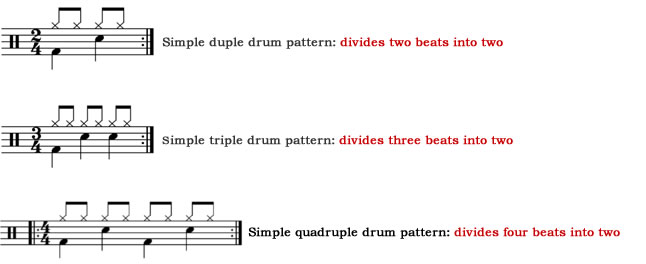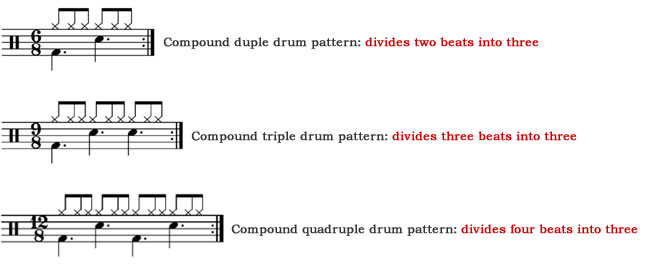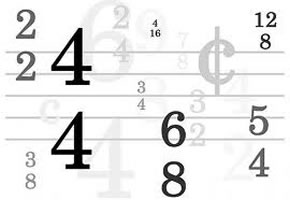Time Signature
The Rhythm of the MusicA Time Signature consists of 2 figures in the form of a fraction, placed together at the beginning of every piece of music. It defines the rhythm and structure of the music helping musicians follow the appropriate beat and count the measures accurately.
- Tempo is the speed or rate of a piece of music usually measured in beats per minute (bpm).
- Rhythm, on the other hand, is how the music moves and feels in time — it's the timing and pattern of musical sounds and silences, dividing the music into metrical phrases or groupings.
- While tempo stays consistent (unless intentionally changed), rhythm can vary throughout a piece — shaping the groove, feel, and phrasing of the music.
A change in rhythm can be indicated by:
| Method | Example |
|---|---|
| 🎼 New rhythmic notation | Notes/rests/ties/dots |
| 🕒 Time signature change | 4/4 → 3/4 |
| ✍️ Text instructions | Swing, Rubato, Double time |
| 🎯 Articulations | Staccato, accent, phrasing |
Understanding Time Signatures
- A Time Signature consists of an upper numeral and a lower numeral.
- The upper numeral indicates how many beats there are in a bar.
- The lower numeral indicates the note value which represents one beat.
- Example: In 4/4 time, there are 4 beats in each bar with each beat represented by a quarter note.
- Example: In 6/8 time there are 6 beats in each bar with each beat represented by an eighth note.
- In a musical score, the time signature appears at the beginning of the piece, immediately following the key signature. This can be in the form of a time symbol, 𝄵 which represents cut time (2/2), or in the form of stacked numerals such as 4/4, 3/4, 6/8 etc. 4/4 time can also be represented by the symbol C
- If the piece is in the key of C Major or A minor where there is no key signature (sharps or flats), the time signature is placed straight after the Clef sign.
- Sometimes you will see another time signature midway through a piece. This occurs when there is a change of rhythm or timing. When this occurs you will see the new time signature following a bar line. All the music shown after the new time signature will be played according to the new time.
- Time signatures not only dictate how many beats to count but also influence the feeling of the music. For example, 3/4 feels like a waltz, whereas 4/4 feels more grounded and steady.
Common Time Signatures
- 2/2 - denotes 2 half notes or 2 minim beats to the bar
- 2/4 - denotes 2 quarter notes or 2 crotchet beats to the bar (♩)
- 3/4 - denotes 3 quarter notes or 3 crotchet beats to the bar (♩)
- 4/4 - denotes 4 quarter notes or 4 crotchet beats to the bar (♩)
- 3/8 - denotes 3 eighth notes or quaver beats to the bar (♪)
- 6/8 - denotes 6 eighth notes or quaver beats to the bar (♩)

Common or 4/4 time: four beats per measure, and each beat is the duration of a quarter note or crotchet.

Alla Breve (cut time): 2 half-note or minim beats per bar
Time is divided into 2 classes: Simple and Compound
- Simple Time consists of undotted notes for beats each divisible into 2 equal parts
- Compound Time consists of dotted notes for beats each divisible into 3 equal parts
Each class contains 3 kinds:
- a) Duple
- b) Triple
- c) Quadruple
Simple Time
- Simple Duple has 2 undotted notes for beats in each bar - each divisible into 2 equal parts
- Simple Triple has 3 undotted notes for beats in each bar - each divisible into 2 equal parts
- Simple Quadruple has 4 undotted notes for beats in each bar - each divisible into 2 equal parts

Compound Time
- Compound Duple has 2 dotted notes for beats in each bar - each divisible into 3 equal parts
- Compound Triple has 3 dotted notes for beats in each bar - each divisible into 3 equal parts
- Compound Quadruple has 4 dotted notes for beats in each bar - each divisible into 3 equal parts

Dotted Notes
When a dot is placed after a note, the time of the note is increased by half again.
- A dotted whole-note: 4 beats + 2 beats (½ of 4 beats) = 6 beats in total
- A dotted half-note: 2 beats + 1 beat (½ of 2 beats) = 3 beats in total
- A dotted quarter-note: 1 beat + 1⁄2 beat (½ of 1 beat) = 1 ½ beats in total
- A dotted eighth-note: 1⁄2 + 1⁄4 (½ of ½ beat) = 3⁄4 of a beat in total
| Note | Name (American) | Name (British) | Beats |
|---|---|---|---|
| Dotted Whole Note | Dotted Semibreve | 6 | |
| Dotted Half Note | Dotted Minim | 3 | |
| Dotted Quarter Note | Dotted Crotchet | 1 ½ | |
| Dotted Eighth Note | Dotted Quaver | 3⁄4 |
Accent & Syncopation
Accent is stress or emphasis on certain notes. When the accent is moved to a weak beat, syncopation is formed.
- In Duple Time: (2 beats/bar) The accents are Strong - Weak
- In Triple Time: (3 beats/bar) The accents are Strong - Weak - Weak
- In Quadruple Time: (4 beats/bar) The accents are Strong - Weak - Medium - Weak
Syncopation is also formed when a note that is just before or just after the beat is stressed.You may have a 4/4 bar | 1+ 2+ 3+ 4+ | where the accent is placed on the + of 4+...
Normally the accent would be on beats 1 and 3, and with syncopation, beats 2 and 4, e.g., reggae. But in this example, the syncopated beat lies beyond the normal beats in the bar... the + of 4+.
The following is an excerpt from Wikipedia...
Technically, "syncopation occurs when a temporary displacement of the regular metrical accent occurs, causing the emphasis to shift from a strong accent to a weak accent." "Syncopation is," however, "very simply, a deliberate disruption of the two-beat or three-beat stress pattern, most often by stressing an off-beat, or a note that is not on the beat..." learn more about Syncopation at Wikipedia
The Use of Simple & Compound Time Signatures
Simple Time Signatures and where they are used:

4/4: Common Time - Widely used in most forms of Western popular music. Most common time signature in rock, blues, country, folk, funk and pop including a wide variety of modern genres introduced over the last few decades.
2/2: Cut Time or Alla Breve - commonly used in fast orchestral music and marches. You will also find it in musical theatre and some forms of popular music.
4/2: Never found in early music and rare since 1600, although Brahms and other composers used it occasionally.
2/4: Used for polkas and marches.
3/4: Used for waltzes, minuets, scherzi, country & western ballads, and sometimes used in pop.
3/8: Also used for the above, but usually suggests a faster tempo.Compound Time Signatures and where they are used:
6/8: Polkas Double jigs, tarantella, sega, barcarolles, marches, loures, and some rock music.
9/8: Compound Triple Time - occurs rarely - used in triple or 'slip' jigs.
12/8: Commonly used in slow blues. It is also known as the doo-wup or shuffle. It is being used in some forms of rock music and you will hear it in some jigs... a popular example of this is The Irish Washerwoman.